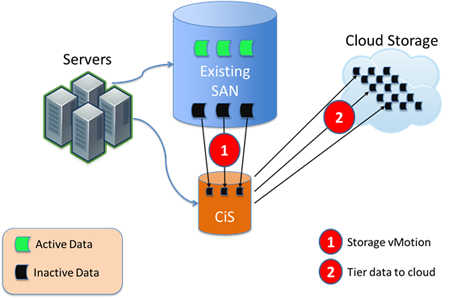Marc Farley is senior director of communities and customer programs at StorSimple and has over 20 years of experience in the network storage industry.
 MARC FARLEY
MARC FARLEYStorSimple
Data storage consumes a disproportionate amount of money and management effort in most enterprises, so it’s not a huge surprise that enterprise IT leaders are wondering if the cloud can help them manage it more effectively. Cloud storage services have the potential to provide more affordable pay-as-you-grow economics, but there has to be enabling technology that allows enterprises to tap into the cloud’s cost-saving potential.
A new storage technology, called Cloud-integrated Storage (CiS) shows excellent potential to be the missing cloud link for enterprise storage customers. CiS is an on-premises SAN storage system that exports LUNs like any other SAN array and also connects to cloud storage services for storing snapshot, backup, inactive and archive data. In many respects, CiS is an extension of the hybrid SAN concept, complete with flash SSD and spinning disk tiers but also with an additional slower, higher-latency cloud storage tier. It’s an architecture that is particularly well suited to the growing amounts of unstructured, inactive data that currently consumes high-cost primary storage capacity.
Benefits of Cloud-integrated Storage
Just as storage volumes in hybrid arrays transparently span both SSDs and HDDs, volumes in CiS systems span SSDs, HDDs and cloud storage services. The CiS system creates, maintains and stores metadata with the data, creating a small metadata-infused data object that is used to determine which tier it should be placed on. When data is first written it is placed in the SSD tier and as its activity level tapers off it is stored on the HDD tier. As the data ages and its activity level further declines, it becomes a candidate for cloud storage. When policy-based capacity thresholds are met, the CiS system tiers inactive CiS data objects to the cloud storage tier. The capacity that the data consumed on-premises is freed and available to be used for new data.
This aligns well with the desires of IT executives who want to shift their budgets towards operating expenses and away from capital purchases. With CiS, new capacity in the cloud is purchased incrementally with operating-budget dollars, which means the company can defer spending capital on storage upgrades for its existing arrays.
Enterprise Storage Scenarios
There are two basic scenarios for enterprise storage customers – one for NAS and one for SAN. The first is where CiS is used to offload capacity from NAS storage. Customers move file shares from an existing NAS system to a file server that uses a CiS system as the storage “back end”. As the file share on the CiS system fills, inactive data is tiered to the cloud.
The second scenario uses CiS as secondary storage for an existing SAN. Administrators run an application that identifies inactive data on their existing SAN and then they move it to their CiS system. For instance, an administrator can run a VMware management tool that identifies inactive VMs and then use Storage vMotion to move the corresponding VMDKs onto a CiS system. The Figure below illustrates.

Figure 1. A CiS system offloads inactive data and tiers it to the cloud.
This method gives administrators a way to gracefully manage VM sprawl and prevents them from having to make emergency decisions about what VMDKs to delete when their SAN storage becomes full. Instead of reacting to a crisis, they now have the time to manage storage capacity as part of a planned process. Their CiS array and cloud storage gives them storage headroom to work with.
CiS systems can also use data reduction technologies such as de-duplication and compression to minimize the capacity that data consumes – both on-premises and in the cloud. While results will vary, virtual server environments can expect to experience dedupe ratios in the range of 4x to 5x. This is a huge advantage for primary storage and the savings also extend to cloud data transfer and storage costs.
Inserting Into Existing Infrastructure
Companies can take advantage of cloud economics by inserting CiS into their existing storage infrastructure, tiering inactive data to the cloud and getting more use from their existing storage arrays. CiS technology is useful today and has a lot of promise for the future too - both for on-premises computing as well as for cloud computing.
Industry Perspectives is a content channel at Data Center Knowledge highlighting thought leadership in the data center arena. See our guidelines and submission process for information on participating. View previously published Industry Perspectives in our Knowledge Library.




